
- SOCIOLOGICAL IMAGINATION

SOCIOLOGICAL IMAGINATION: COLLEGE ENROLLMENT IN CONTEXT

So…how can we use the sociological imagination to help students understand why they are sitting there in the classroom? Especially for first year students, the seemingly very individual process of deciding if and where to go to college is fresh in their minds.

C. Wright Mills (1916-1962) presents the sociological imagination as the ability to see the relationship between one’s individual life and the effects of larger social forces. One way to help students see all the external forces that have influenced their arrival in your classroom is to push them to answer the question: “Why did you enroll in college?”
“To learn.” Can’t you learn on your own? Studying what you want, when you want at a much lower cost?
“Okay, so to earn a degree.” This is a great place to talk about how our society is increasingly credentialed . The college, accrediting organizations, deans, professional associations all define what it takes to be awarded a degree, a certificate that serves as a cultural symbol of legitimation and distinction, helping to sort people into categories. You see these hung on walls in offices to signal expertise to others. As an individual, you make choices, but those choices are influenced by a modern social context that makes the consequences of those choices very real.
“If I don’t have a degree, I won’t get a good job.” After WWII, the options for those with a high school diploma to earn a middle class living in the US were far greater than they are now. The largely successful effort of companies to break unions have greatly decreased the number of employees that can collectively bargain with management. Additionally, neoliberal globalization of the economy has contributed to deindustrialization – many manufacturing jobs have moved to less developed countries with lower wages. The context with which individuals make decisions changed, the social context changed.
“If I don’t get a good job I will struggle to afford housing, health care, and a college education for any children I have.” Additionally, we live in an economic market that requires people to earn wages, mostly by selling their labor (hello Marx). Few if any of your students will work for themselves, own a business, or avoid wage labor. Their “choice” to pursue a college degree was hardly a choice. This can be seen by exploring the alternative…what would they be doing if they were not in college? Compared to many other advanced industrialized nations, the US has a weak social safety net that leaves individuals vulnerable to market forces.
While embedded in the time, place, and structure of our own society, it may be difficult to see the social forces that Mills encouraged us to see in order to more fully understand our world. By looking at college enrollment rates over time, students can see that the historical moment, the society, that they occupy now is very different compared to 50 years ago. Mills speaks of the intersection between history and biography. Looking at a different point in time shows us how our biography may have been different. Especially for women, the likelihood that they would have been enrolled in college if they were transported back to 1967, a different social context, is much smaller. More than double the rate of women are now enrolled.
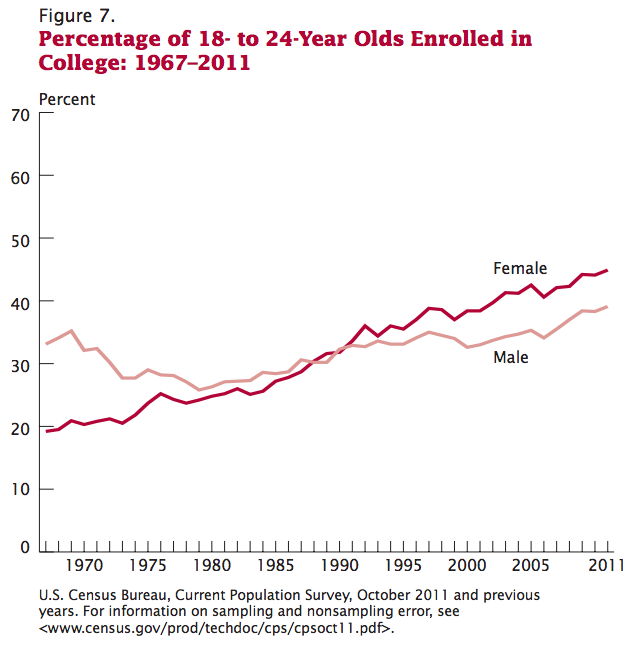
Increasingly, international students make up larger portion of the student body at colleges and universities in the US. This is a dramatic change from your parents experiences in higher education and has been largely facilitated by changes in our social context: increasing globalization, financial stress of colleges and universities, changing demographic distributions in the US that will decrease the overall number 18 year olds applying to college.
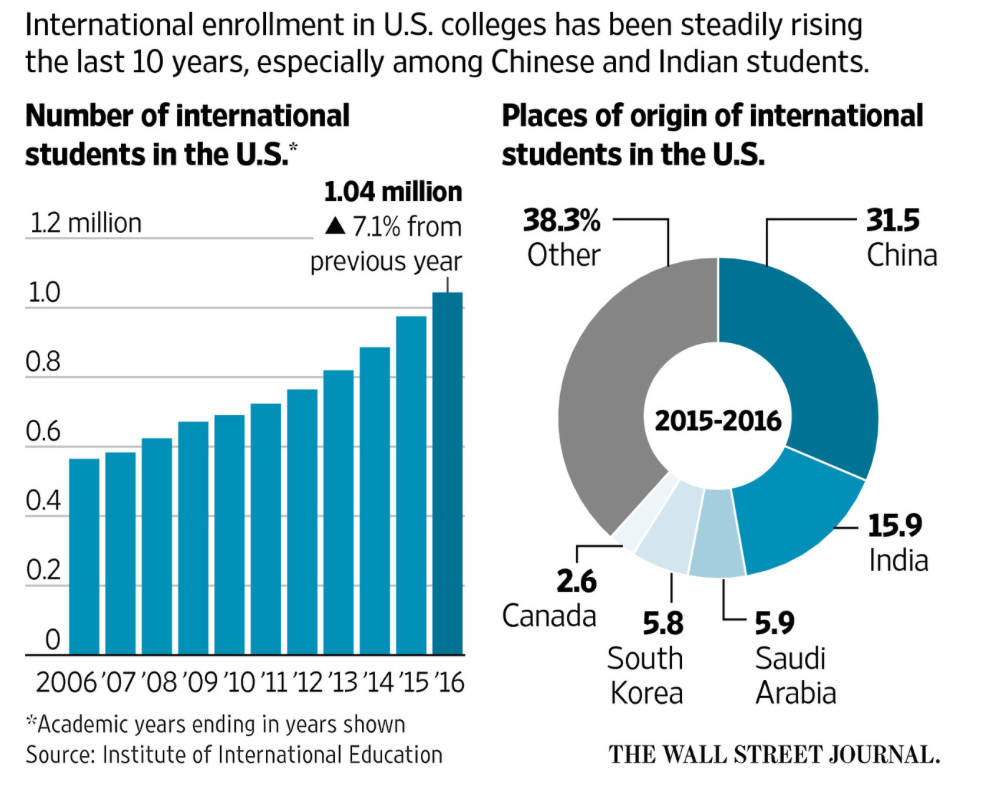
Enrollment levels in other nations today also help us use our sociological imagination and to see that society has an influence on our individual decisions. The figure below shows UNESCO data for 2011 enrollment in tertiary education (post-secondary of any type, including college) across select nations.
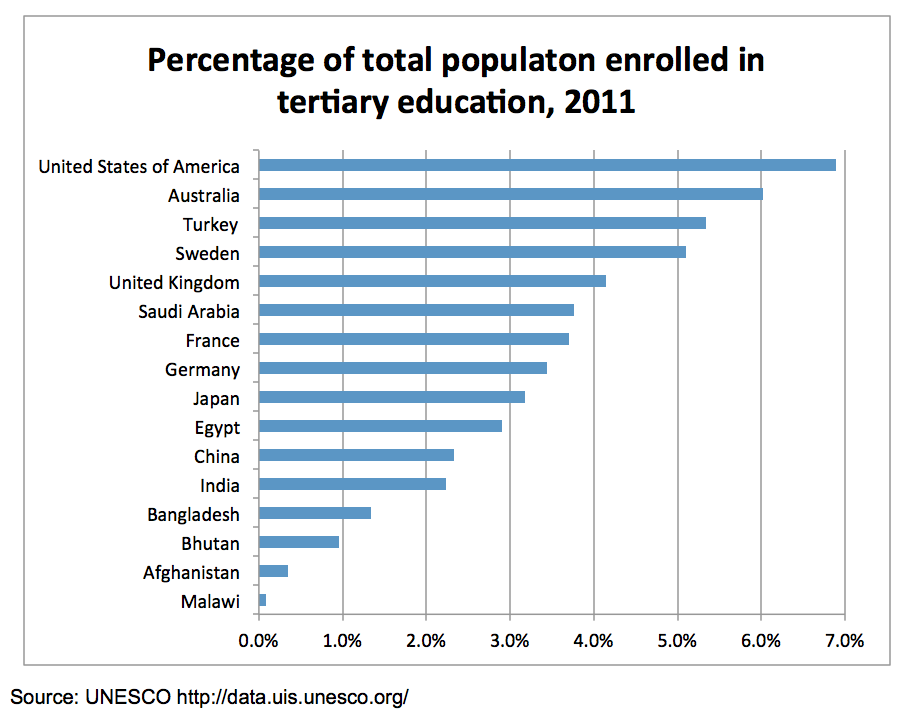
Living in a different society, with different resources, economy, culture, and institutions would dramatically alter your “individual” decision to enroll in college. To understand this is to use the sociological imagination.
Society not only influence how many people go to college, but a college education influences society in many ways as well.
In the most recent presidential election, the counties with the highest rate of college educated citizens overwhelmingly voted for Hillary Clinton. While the counties with the lowest rates of college educated population voted for Trump.
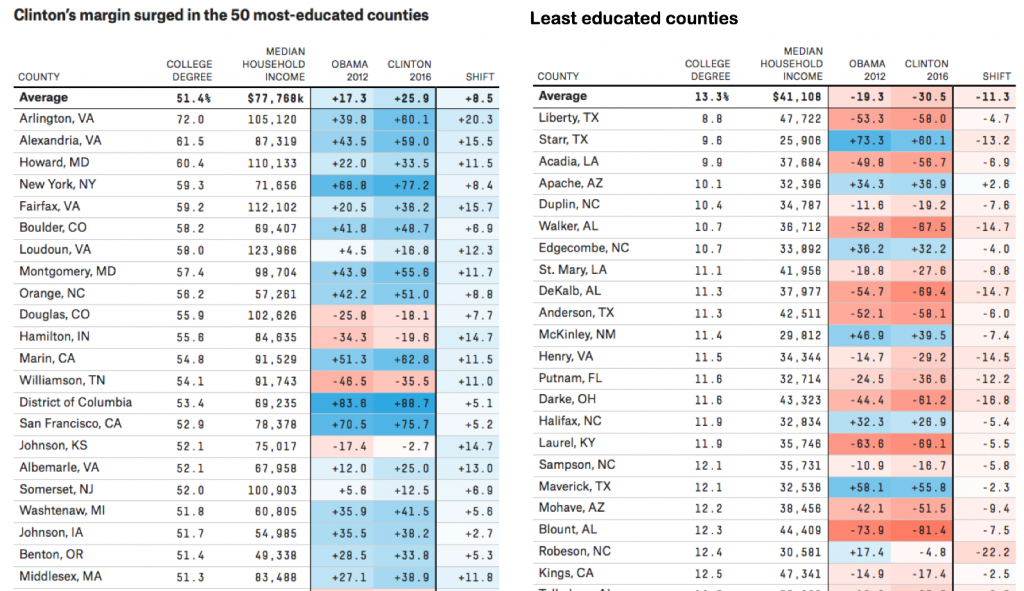
Not surprisingly, people with higher levels of education in today’s society earn more money and have lower rates of unemployment on average.
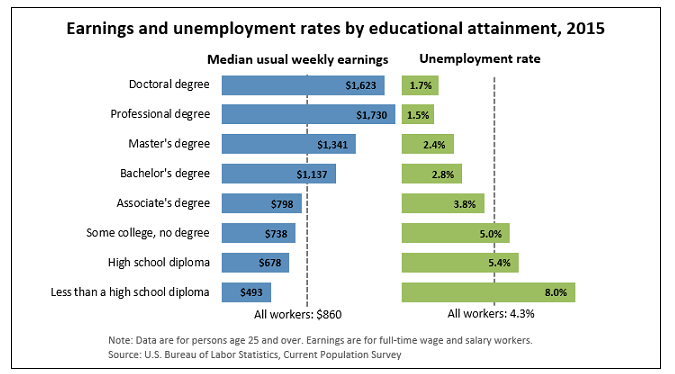
Here is another way of looking at that shows, on average, how much more people earn per advancement in education.
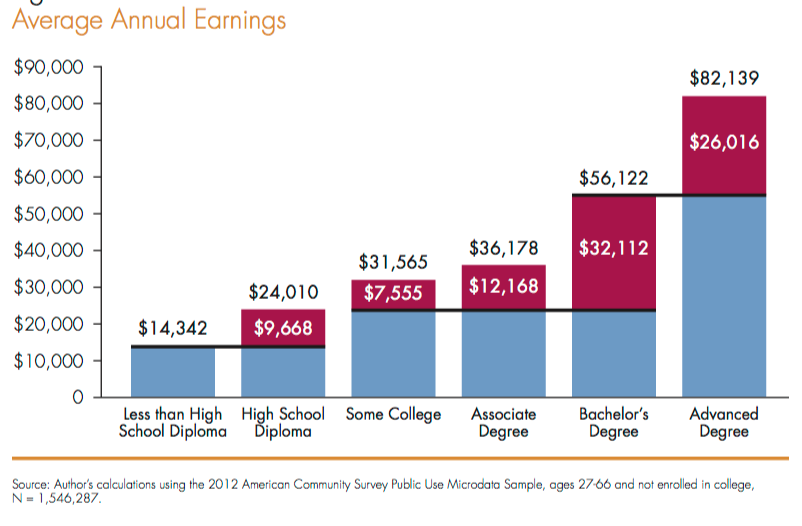
Also, the greater the education level, the more likely to be married and he more likely to vote.
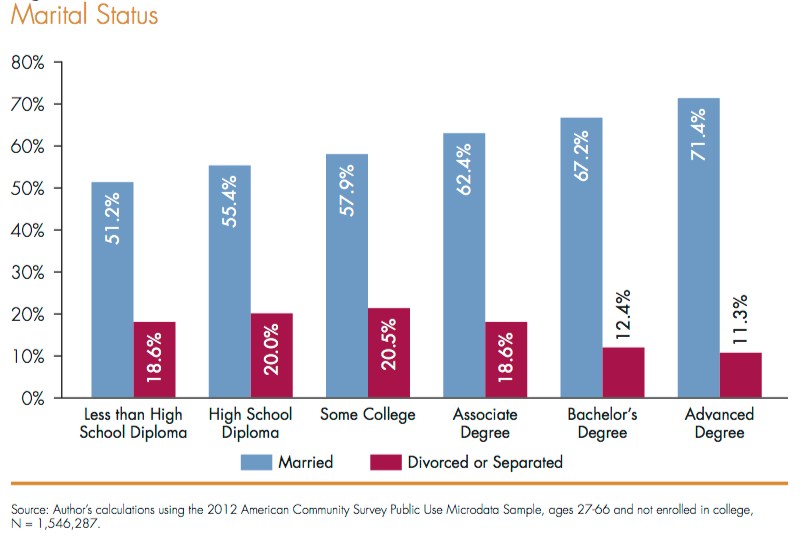
Teach well, it matters.
Additional resources:
See my previous post on illuminating the sociological imagination by looking at marriage across time and other cultures.
Massengill, Rebekah Peeples . 2011. “Sociological Writing as Higher-level Thinking: Assignments that Cultivate the Sociological Imagination.” Teaching Sociology 39(4): 371-381.
Nell Trautner, Mary ; Borland, Elizabeth . 2013. “Using the Sociological Imagination to Teach about Academic Integrity.” Teaching Sociology 41(4): 377-388.
Noy, Shiri. 2014. “Secrets and the Sociological imagination: Using PostSecret.com to Illustrate Sociological Concepts.” Teaching Sociology 42(3): 187-19
Packard, Josh . 2013. “The Impact of Racial Diversity in the Classroom: Activating the Sociological Imagination.” Teaching Sociology 41(2): 144-158.
Unnithan, N. Prabha . 1994. “Using Students’ Familiarity and Knowledge to Enliven Large Sociology Classes.” Teaching Sociology 22(4): 333-336.
Shawndra Barnes — August 23, 2016
This was a very interesting perspective. I guess I never really thought of it this way, but it is very true. I am a non traditional student and I know first hand that it is a struggle trying to survive without a degree. I went so long trying to make ends meet that I finally realized if I want to be successful and financially less stressed, I had to go back to school. Though it was a choice I made it was also the only financial improvement choice that was available and also legal. Therefore it did not quite feel like a choice as much as a necessity in today's society.
TEACHING SOCIOLOGY: Tools to start a new semester - Sociology Toolbox — January 10, 2018
[…] second one examines higher education and the act of deciding to come to college through a sociological lens. […]
Tristan — July 5, 2018
I did not know that
Tristan Hicks — July 8, 2018
John — june 23, 2019.
Not a huge surprise about the female to male discrepancy in higher education. When the faculty is made up of over 75 percent female, the instrcutors bias , and sexual preference goes up.
Leave a Reply Cancel reply
Your email address will not be published. Required fields are marked *
Save my name, email, and website in this browser for the next time I comment.
About Sociology Toolbox
Todd Beer, PhD, is a faculty member in the department of Sociology and Anthropology at Lake Forest College, a wonderful liberal arts college north of Chicago. Read more…
CC Attribution Non-Commercial Share Alike

Choose Your Test
Sat / act prep online guides and tips, what is sociological imagination how can you use it.
General Education

Have you ever wondered why your family cooks turkey on Thanksgiving? If you ask, you might get all kinds of reasons: because it’s tradition, because it tastes good, because it’s what the pilgrims ate back in the early days of America. All of those factors—taste, personal history, and world history—lead to one small action of you eating turkey on a holiday.
That’s the premise of sociological imagination. Like imagination in the more typical sense, the sociological imagination asks us to use our brains to think differently about things and consider why we do the things we do.
In this article, we’ll introduce the concept of sociological imagination, its history, how it changed the sociological field, and how you can use it every day to change your way of thinking about the world.
What Is Sociological Imagination?
The sociological imagination is a method of thinking about the world. As you may have guessed, it’s part of the field of sociology, which studies human society.
When you put “sociological”—studying society—and “imagination”—the concept of forming new ideas, often creatively—together, you get a pretty good definition of the concept: a method of thinking about both individuals and society by considering a variety of sociological contexts.
The societal imagination encourages people to think about their lives not just on an individual level, but also considering societal, biological, and historical context. Societal context tells us about our culture—when we consider it, we think about how our desires, actions, and thoughts are shaped by our community and how that community is changing. Biological context tells us about how “human nature” impacts our desires and needs. And lastly, historical context considers our place in time; how have events of the past led up to where we are currently?
Basically, the concept of sociological imagination suggests that who you are as an individual is also the you shaped by your immediate surroundings, your family, your friends, your country, and the world as a whole. You may make individual choices about what to eat for lunch, but what you choose—a tuna sandwich, lobster ravioli, or shrimp tacos—is also determined by societal factors like where you live and what you’ve grown up eating.
To use the sociological imagination is to shift your perspective away from yourself and look at things more broadly, bringing in context to individual actions.
If you’re thinking about lunch, you’re probably more likely to choose something that’s familiar to you. In another culture or even another part of your city, a person who is very similar to you might choose a different food because of what’s familiar to them. If we zoom out a little further, we might realize that people in landlocked states might be unlikely to choose a seafood-based lunch at all because fresh fish is more expensive than it is on the coast. Zoom out more, and you might realize that fish isn’t even on the menu for some cultures because of societal taboos or restrictions.
And those are just spatial boundaries. You can also consider your family’s relationship with eating fish, or how your cultural and ethnic heritage impacted where you are, what food you have access to, and your personal tastes. All of this lets you see yourself and your culture in a new light, as a product of society and history.
In this sense, using a sociological imagination lets you look at yourself and your culture as a third-party observer. The goal is not to be dispassionate and distant, but rather to see yourself not as “natural” or “normal,” as a part of larger systems, the same way that all people are.

Why the Sociological Imagination Is Useful
Part of the appeal of using a sociological imagination is that it helps people avoid apathy . In this context, apathy refers to a sense of indifference or disinterest in examining the morality of their leaders. According to C. Wright Mills , creator of the idea of sociological imagination, if we accept that our beliefs, traditions, and actions are all normal and natural, we are less likely to interrogate when our leaders and community members do things that are immoral.
Considering sociological context allows individuals to question and change society rather than just live in it. When we understand historical and social contexts, we’re better equipped to look at our actions and the actions of our community as a result of systems—which can be changed—rather than as inherent to humanity.
In more technical terms, Mills was challenging the dominant structural functionalist approach to sociology. Structural functionalism suggests that society is composed of different structures that shape the interactions and relationships between people, and those relationships can be understood and analyzed to help us learn more about a society.
What differed for Mills and his concept of the sociological imagination was that he believed that society was not only a series of systems, but that the role of the individual should also be considered. In fact, Mills believed that social structures arise because of conflict between groups , typically the elite and the others, such as the government and the citizens or the rich and the poor.
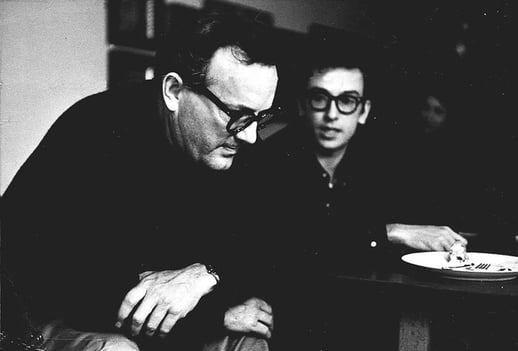
Where Does the Term Come From?
As previously mentioned, C. Wright Mills is the origin of the term “sociological imagination.” In his 1959 book The Sociological Imagination , the Columbia University professor of sociology suggested that sociologists rethink the way they were engaging with the field. During his time, many sociologists engaged in a sort of top-down view of the world, focusing on systems rather than on individuals. Mills believed both were important, and that society should be understood as a relationship between different systems that originated in conflict.
Though his book has since been named one of the most important sociological texts of the 20th century, Mills was not popular among his contemporaries. Mills was particularly concerned with class in social spheres, particularly the elite and the military, and how conflict between the elite and the non-elite impacted the actions of individuals and vice-versa.
Mills was also opposed to the tendency of sociologists to observe rather than act. He believed that sociology was a great tool for changing the world, and believed that using the sociological imagination encouraged people of all kinds, including sociologists, to expose and respond to social injustice.
Mills referred to the tendency of sociologists to think in abstraction “grand theory.” This tendency led to sociologists of the time being more concerned with organization and taxonomy over understanding—because Mills was so concerned with the experience of the individual as well as the experience of the whole, this contributed to his feeling that the sociological field was too far removed from the actual humans that comprise society.
Because so much of Mills’ ideas of the sociological imagination were intended to bring sociologists closer to the people and their concerns, he developed a series of tenets to encourage them to think differently.

Mills’ Sociological Imagination Tips
Mills' book was all about how the sociological imagination could help society, but it wasn't only a theoretical approach. The Sociological Imagination contained tips for sociologists as well as the general public to help them better contextualize the world!
Avoid Existing Sets of Procedures
So much of sociology was based on existing systems that Mills felt the field focused on method over humanity. To combat this, he suggested that sociologists should function as individuals and propose new theories and methodologies that could challenge and enhance established norms.
Be Clear and Concise
Mills believed that some of the academic language used in the field of sociology encouraged the sense of distance that so troubled him. Instead, he advocated that sociologists be clear and concise when possible, and that they do not couch their theories in language intended to distance themselves from society and from criticism.
Observe the Macro and Micro
Prior to Mills’ work, structural functionalism was the primary philosophy of the field. Mills disagreed with the top-down approach to sociology, and encouraged sociologists to engage with the macro, as they had been doing, in addition to the micro. He believed that history is comprised of both the big and small, and that study of each is required for a robust field.
Observe Social Structure as Well as Milieu
Building off of his last point, Mills also suggested that social structure and individual actions, which he called “milieu,” were interconnected and equally worthy of study. He explained that individual moments, as well as long spans of time, were equally necessary to understanding society.
Avoid Arbitrary Specialization
Mills advocated for a more interdisciplinary approach to sociology. Part of the sociological imagination is thinking outside of the boundaries of yourself; to do so, Mills suggested that sociologists look beyond their specialized fields toward a more comprehensive understanding.
Always Consider Humanity and History
Because so much of sociology in the time of Mills’ writing was concerned with systems, he advocated for more consideration of both humanity and history. That meant looking at human experience on an individual and societal level, as well as within a specific and broad historical context.
Understand Humanity as Historical and Social Actors
Mills wanted sociologists to consider humans as products of society, but also society as products of humanity. According to Mills, people may act on an individual basis, but their individual desires and thoughts are shaped by the society in which they live. Therefore, sociologists should consider human action as a product of not just individual desires, but also historical and social actors.
Consider Individuals in Connection with Social Issues—Public is Personal, Personal is Public
One of Mills’ biggest points was that an individual problem is often also a societal problem. He suggested that sociologists should look beyond the common discourse and find alternate explanations and considerations.

2 In-Depth Sociological Imagination Examples
The sociological imagination can be complex to wrap your mind around, particularly if you’re not already a sociologist. When you take this idea and apply it to a specific example, however, it becomes a lot easier to understand how and why it works to broaden your horizons. As such, we've developed two in-depth sociological imagination examples to help you understand this concept.
Buying a Pair of Shoes
Let’s start with a pretty basic example—buying a pair of shoes. When you think about buying a new pair of shoes, your explanation may be fairly simple, such as that you need a new pair of shoes for a particular purpose, like running or a school dance, or that you simply like the way they look. Both of those things may be true, but using your sociological imagination takes you out of the immediacy of those to answers and encourages you to think deeper.
So let’s go with the first explanation that you need a new pair of running shoes. Our first step toward using the sociological imagination is asking yourself ‘why?’ Well, so you can go running, of course! But why do you want to go running, as opposed to any other form of exercise? Why get into exercise at all? Why new running shoes rather than used ones?
Once you start asking these questions, you can start to see how it’s not just an individual choice on your part —the decision to buy running shoes is a product of the society you live in, your economic situation, your local community, and so on. Maybe you want to go running because you want to get into shape, and your favorite Instagram profile is big into running. Maybe you recently watched a news report about heart health and realized that you need a new exercise regimen to get into shape. And maybe you’ve chosen new shoes over used ones because you have the financial means to purchase a name-brand pair.
If you were a different person in a different context—say if you lived in a poorer area, or an area with more crime, or another country where other forms of exercise are more practical or popular—you might have made different choices. If you lived in a poorer area, designer shoes may not even be available to you. If there was a lot of crime in your area, running might be an unsafe method of exercise. And if you lived in another country, maybe you’d take up biking or tai chi or bossaball.
When you consider these ideas, you can see that while you’re certainly an individual making individual decisions, those decisions are, in part, shaped by the context you live in. That’s using your sociological imagination—you’re seeing how the personal decision of buying a pair of running shoes is also public, in that what is available to you, what societal pressures you experience, and what you feel are all shaped by your surroundings.
Who People Choose to Marry
Marriage for love is the norm in American culture, so we assume that the same is true and always has been true. Why else would anybody marry?
When we use our sociological imaginations, we can figure it out. You might get married to your partner because you love them, but why else might you get married? Well, it can make your taxes simpler, or make you more qualified to get a home loan. If your partner is from another country, it might help them stay within the US. So even in the United States, where marriage is typically thought of as a commitment of love, there are multiple other reasons you might get married.
Throughout history, marriage was a means to make alliances or acquire property, usually with a woman as a bargaining chip. Love wasn’t even part of the equation—in fact, in ancient Rome one politician was ousted from the Senate for having the gall to kiss his wife in public .
It wasn’t until the 17th and 18th centuries that love became a reason to marry, thanks to the Enlightenment idea that lives should be dedicated to pursuing happiness. But at that point, women were still seen more like property than people—it wasn’t until the women’s rights movements of the 1900s that American women advocated for their own equality in marriage.
In other cultures, polygamy might be acceptable, or people might have arranged marriages, where a person’s family chooses their spouse for them. That sounds strange to us, but only because in our culture the norm is marrying for love, with other reasons, such as financial or immigration concerns, being secondary.
So even for an individual, there might be multiple factors at play in the decision to be made. You may never articulate these desires because getting married for love is our cultural norm (and it wouldn’t sound very good in a wedding speech), but these kinds of considerations do have subconscious effects on our decision-making.

Sociological Imagination in the Sociology Community
As you might have gathered from the numerous challenges Mills’ concept of the sociological imagination posed to established practices, he wasn’t a super popular figure in sociology during his time.
Many sociologists were resistant to Mills’ suggested changes to the field. In fact, Mills is sometimes heralded to be ahead of his time , as the values he espoused about human connection and societal issues were prominent thoughts in the 1960s, just after his death.
One of his former students wrote about how Mills stood in contrast to other sociologists of the era, saying:
“Mills’s very appearance was a subject of controversy. In that era of cautious professors in gray flannel suits he came roaring into Morningside Heights on his BMW motorcycle, wearing plaid shirts, old jeans and work boots, carrying his books in a duffel bag strapped across his broad back. His lectures matched the flamboyance of his personal image, as he managed to make entertaining the heavyweight social theories of Mannheim, Ortega and Weber. He shocked us out of our Silent Generation torpor by pounding his desk and proclaiming that every man should build his own house (as he himself did a few years later) and that, by God, with the proper study, we should each be able to build our own car! “Nowadays men often feel that their private lives are a series of traps,” Mills wrote in the opening sentence of The Sociological Imagination, and I can hear him saying it as he paced in front of the class, speaking not loudly now but with a compelling sense of intrigue, as if he were letting you in on a powerful secret.”
Though Mills’ philosophy is hugely important to today’s sociology field, his skewering of power and the myopic nature of his era’s academics didn’t make him many friends .
However, as time has gone on, the field has come to regard him differently. His challenge to the field helped reshape it into something that is concerned with the macro as well as the micro. Conversations—even negative ones—about Mills’ proposals helped circulate his ideas, leading to The Sociological Imagination eventually being voted as the second most important sociological text of the 20th century .

How to Apply Sociological Imagination to Your Own Life
The great thing about sociological imagination is that you don’t need to be a trained sociologist to do it. You don’t need a huge vocabulary or a deep understanding of sociological texts—just the willingness to step outside of your own viewpoint and consider the world in context.
This helps you escape your own perspective and think about the world differently. That can mean you’re able to make decisions less tinged with cultural bias—maybe you don’t need those expensive running shoes after all.
To train your sociological imagination, get into the habit of asking questions about behavior that seems “normal” to you. Why do you think it’s normal? Where did you learn it? Are there places it may not be seen as normal?
Consider a relatively common tradition like Christmas, for example. Even if you don’t come from a particularly religious family, you may still celebrate the holiday because it’s common in our society. Why is that? Well, it could be that it’s a tradition. But where did that tradition come from? Probably from your ancestors, who may have been more devout than your current family. You can trace this kind of thinking backward and consider your personal history, your family history, and the surrounding cultural context (not all cultures celebrate Christmas, of course!) to understand how something that feels “normal” got to that state.
But cultural context isn’t the only important part of the sociological imagination—Mills also suggested that sociologists should consider the personal and the public, as well. When you come upon something that seems like a personal issue, think about it in a societal context. Why might that person behave the way that they do? Are there societal causes that might contribute to their situation?
A common example of this is the idea of unemployment. If you are unemployed, you may feel simultaneous feelings of frustration, unease, and even self-loathing. Many people blame themselves for their lack of a job, but there are societal factors at play, too. For example, there may simply be no jobs available nearby, particularly if you’re trained in a specific field or need to hit a certain income level to care for your family. You may have been laid off due to poor profits, or even because you live in a place where it’s legal to terminate employment based on sexuality or gender identity. You may be unable to find work because you’re spending so much time caring for your family that you simply don’t have time to apply for many jobs.
So while unemployment may seem like a personal issue, there are actually lots of societal issues that can contribute to it. Mills’ philosophy asks us to consider both in conversation with one another—it’s not that individuals have no free will, but rather that each person is a product of their society as well as an individual.
What’s Next?
Psychology, like sociology, can give us insight into human behavior. If you're thinking of studying psychology in the future, this list of psychology master's programs can give you a great look at which colleges have the best programs!
Sociology can even help you understand works of literature, like The Great Gatsby ! Learn more about F. Scott Fitzgerald's take on the American Dream from our guide.
A good understanding of history is one of the core pieces to a good sociological imagination. To improve your historical knowledge, consider these high school history classes you should take !

Melissa Brinks graduated from the University of Washington in 2014 with a Bachelor's in English with a creative writing emphasis. She has spent several years tutoring K-12 students in many subjects, including in SAT prep, to help them prepare for their college education.
Ask a Question Below
Have any questions about this article or other topics? Ask below and we'll reply!
Improve With Our Famous Guides
- For All Students
The 5 Strategies You Must Be Using to Improve 160+ SAT Points
How to Get a Perfect 1600, by a Perfect Scorer
Series: How to Get 800 on Each SAT Section:
Score 800 on SAT Math
Score 800 on SAT Reading
Score 800 on SAT Writing
Series: How to Get to 600 on Each SAT Section:
Score 600 on SAT Math
Score 600 on SAT Reading
Score 600 on SAT Writing
Free Complete Official SAT Practice Tests
What SAT Target Score Should You Be Aiming For?
15 Strategies to Improve Your SAT Essay
The 5 Strategies You Must Be Using to Improve 4+ ACT Points
How to Get a Perfect 36 ACT, by a Perfect Scorer
Series: How to Get 36 on Each ACT Section:
36 on ACT English
36 on ACT Math
36 on ACT Reading
36 on ACT Science
Series: How to Get to 24 on Each ACT Section:
24 on ACT English
24 on ACT Math
24 on ACT Reading
24 on ACT Science
What ACT target score should you be aiming for?
ACT Vocabulary You Must Know
ACT Writing: 15 Tips to Raise Your Essay Score
How to Get Into Harvard and the Ivy League
How to Get a Perfect 4.0 GPA
How to Write an Amazing College Essay
What Exactly Are Colleges Looking For?
Is the ACT easier than the SAT? A Comprehensive Guide
Should you retake your SAT or ACT?
When should you take the SAT or ACT?
Stay Informed
Get the latest articles and test prep tips!
Looking for Graduate School Test Prep?
Check out our top-rated graduate blogs here:
GRE Online Prep Blog
GMAT Online Prep Blog
TOEFL Online Prep Blog
Holly R. "I am absolutely overjoyed and cannot thank you enough for helping me!”
Module 1: Foundations of Sociology
The sociological imagination, learning outcomes.
- Define the sociological imagination
- Apply the sociological imagination

Figure 1. The sociological imagination enables you to look at your life and your own personal issues and relate them to other people, history, or societal structures.
Many people believe they understand the world and the events taking place within it, even though they have not actually engaged in a systematic attempt to understanding the social world, as sociologists do. In this section, you’ll learn to think like a sociologist.
The sociological imagination , a concept established by C. Wright Mills (1916-1962) provides a framework for understanding our social world that far surpasses any common sense notion we might derive from our limited social experiences. Mills was a contemporary sociologist who brought tremendous insight into the daily lives of society’s members. Mills stated: “Neither the life of an individual nor the history of a society can be understood without understanding both” [1] . The sociological imagination is making the connection between personal challenges and larger social issues. Mills identified “troubles” (personal challenges) and “issues” (larger social challenges), also known as biography, and history, respectively. Mills’ sociological imagination allows individuals to see the relationships between events in their personal lives (biography), and events in their society (history). In other words, this mindset provides the ability for individuals to realize the relationship between their personal experiences and the larger society in which they live their lives.
Personal troubles are private problems experienced within the character of the individual and the range of their immediate relation to others. Mills identified that we function in our personal lives as actors and actresses who make choices about our friends, family, groups, work, school, and other issues within our control. We have a degree of influence on the outcome of matters within this personal level. A college student who parties 4 nights out of 7, who rarely attends class, and who never does his homework has a personal trouble that interferes with his odds of success in college. However, when 50% of all college students in the United States never graduate, we label it as a larger social issue.
Larger social or public issues are those that lie beyond one’s personal control and the range of one’s inner life. These pertain to broader matters of organization and process, which are rooted in society rather than in the individual. Nationwide, students come to college as freshmen who are often ill-prepared to understand the rigors of college life. They haven’t often been challenged enough in high school to make the necessary adjustments required to succeed in college. Nationwide, the average teenager text messages, surfs the Net, plays video games, watches TV, spends hours each day with friends, and works at least part-time. Where and when would he or she get experience focusing attention on college studies and the rigorous self-discipline required to transition into college?
The real power of the sociological imagination is found in how we learn to distinguish between the personal and social levels in our own lives. This includes economic challenges. For example, many students do not purchase required textbooks for college classes at both 2-year colleges and 4-year colleges and universities. Many students simply do not have the money to purchase textbooks, and while this can seem like a “choice,” some of the related social issues include rising tuition rates, decreasing financial aid, increasing costs of living and decreasing wages. The Open Educational Resource (OER) movement has sought to address this personal trouble as a public issue by partnering with institutional consortia and encouraging large city and state institutions to adopt OER materials. A student who does not purchase the assigned textbook might see this as a private problem, but this student is part of a growing number of college students who are forced to make financial decisions based on structural circumstances.
A majority of personal problems are not experienced as exclusively personal issues, but are influenced and affected by social norms, habits, and expectations. Consider issues like homelessness, crime, divorce, and access to healthcare. Are these all caused by personal choices, or by societal problems? Using the sociological imagination, we can view these issues as interconnected personal and public concerns.
For example, homelessness may be blamed on the individuals who are living on the streets. Perhaps their personal choices influenced their position; some would say they are lazy, unmotivated, or uneducated. This approach of blaming the victim fails to account for the societal factors that also lead to homelessness—what types of social obstacles and social failings might push someone towards homelessness? Bad schools, high unemployment, high housing costs, and little family support are all social issues that could contribute to homelessness. C. Wright Mills, who originated the concept of the sociological imagination, explained it this way: “the very structure of opportunities has collapsed. Both the correct statement of the problem and the range of possible solutions require us to consider the economic and political institutions of the society, and not merely the personal situation and character of a scatter of individuals.”
Watch the following video to see an example of how the sociological imagination is used to understand the issue of obesity.
- Mills, C. W.: 1959, The Sociological Imagination, Oxford University Press, London. ↵
- Modification, adaptation, and original content. Authored by : Sarah Hoiland for Lumen Learning. Provided by : Lumen Learning. License : CC BY: Attribution
- The Sociological Imagination. Provided by : College of the Canyons. Located at : https://www.canyons.edu/Offices/DistanceLearning/OER/Documents/Open%20Textbooks%20At%20COC/Sociology/SOCI%20101/The%20Sociological%20Imagination.pdf . Project : Sociology 101. License : CC BY: Attribution
- People graphic. Authored by : Peggy_Marco. Provided by : pixabay. Located at : https://pixabay.com/en/network-society-social-community-1019778/ . License : CC0: No Rights Reserved

What Is Sociological Imagination: Definition & Examples
Charlotte Nickerson
Research Assistant at Harvard University
Undergraduate at Harvard University
Charlotte Nickerson is a student at Harvard University obsessed with the intersection of mental health, productivity, and design.
Learn about our Editorial Process
Saul Mcleod, PhD
Editor-in-Chief for Simply Psychology
BSc (Hons) Psychology, MRes, PhD, University of Manchester
Saul Mcleod, PhD., is a qualified psychology teacher with over 18 years of experience in further and higher education. He has been published in peer-reviewed journals, including the Journal of Clinical Psychology.
Olivia Guy-Evans, MSc
Associate Editor for Simply Psychology
BSc (Hons) Psychology, MSc Psychology of Education
Olivia Guy-Evans is a writer and associate editor for Simply Psychology. She has previously worked in healthcare and educational sectors.
- The term sociological imagination describes the type of insight offered by sociology; connecting the problems of individuals to that of broader society.
- C. Wright Mills, the originator of the term, contended that both sociologists and non-academics can develop a deep understanding of how the events of their own lives (their biography) relate to the history of their society. He outlined a list of methods through which both groups could do so.
- Mills believed that American society suffered from the fundamental problems of alienation, moral insensibility, threats to democracy, threats to human freedom, and conflict between bureaucratic rationality and human reason, and that the development of the sociological imagination could counter these.
What is Sociological Imagination?
Sociological imagination, an idea that first emerged in C. Wright Mills’ book of the same name, is the ability to connect one’s personal challenges to larger social issues.
The sociological imagination is the ability to link the experience of individuals to the social processes and structures of the wider world.
It is this ability to examine the ways that individuals construct the social world and how the social world and how the social world impinges on the lives of individuals, which is the heart of the sociological enterprise.
This ability can be thought of as a framework for understanding social reality, and describes how sociology is relevant not just to sociologists, but to those seeking to understand and build empathy for the conditions of daily life.
When the sociological imagination is underdeveloped or absent in large groups of individuals for any number of reasons, Mills believed that fundamental social issues resulted.
Sociological Imagination Theory
C. Wright Mills established the concept of sociological imagination in the 20th century.
Mills believed that: “Neither the life of an individual nor the history of a society can be understood without understanding both” the daily lives of society’s members and the history of a society and its issues.
He referred to the problems that occur in everyday life, or biography, as troubles and the problems that occur in society, or history, as issues.
Mills ultimately created a framework intended to help individuals realize the relationship between personal experiences and greater society (Elwell, 2002).
Before Mill, sociologists tended to focus on understanding how sociological systems worked, rather than exploring individual issues. Mills, however, pointed out that these sociologists, functionalists chief among them, ignored the role of the individual within these systems.
In essence, Mills claimed in his book, The Sociological Imagination , that research had come to be guided more by the requirements of administrative concerns than by intellectual ones.
He critiqued sociology for focusing on accumulating facts that only served to facilitate the administrative decisions of, for example, governments.
Mills believed that, to truly fulfill the promise of social science, sociologists and laypeople alike had to focus on substantial, society-wide problems, and relate those problems to the structural and historical features of the society and culture that they navigated (Elwell, 2002).
Mills’ Guidelines for Social Scientists
In the appendix of The Sociological Imagination, Mills set forth several guidelines that would lead to “intellectual craftsmanship.” These are, paraphrased (Mills, 2000; Ellwell, 2002):
Scholars should not split work from life, because both work and life are in unity.
Scholars should keep a file, or a collection, of their own personal, professional, and intellectual experiences.
Scholars should engage in a continual review of their thoughts and experiences.
Scholars may find a truly bad sociological book to be as intellectually stimulating and conducive to thinking as a good one.
Scholars must have an attitude of playfulness toward phrases, words, and ideas, as well as a fierce drive to make sense of the world.
The sociological imagination is stimulated when someone assumes a willingness to view the world from the perspective of others.
Sociological investigators should not be afraid, in the preliminary and speculative stages of their research, to think in terms of imaginative extremes, and,
Scholars should not hesitate to express ideas in language that is as simple and direct as possible. Ideas are affected by how they are expressed. When sociological perspectives are expressed in deadening language, they create a deadened sociological imagination.
Mills’ Original Social Problems
Mills identified five main social problems in American society: alienation , moral insensibility, threats to democracy, threats to human freedom, and the conflict between bureaucratic rationality and human reason (Elwell, 2015).

1. Threats to Democracy and Freedom
The end result of these problems of alienation, political indifference, and the economic and political concentration of power, according to Mills, is a serious threat to democracy and freedom.
He believed that, as bureaucratic organizations became large and more centralized, more and more power would be placed into the hands of a small elite (Elwell, 2006).
2. Alienation
Mills believed that alienation is deeply rooted in how work itself works in society; however, unlike Marx, C. Wright Mills does not attribute alienation solely to the means of production, but to the modern division of labor .
Mills observed that, on the whole, jobs are broken up into simple, functional tasks with strict standards. Machines or unskilled workers take over the most tedious tasks (Elwell, 2002).
As the office was automated, Mills argued, authority and job autonomy became the attributes of only those highest in the work hierarchy. Most workers are discouraged from using their own judgment, and their decision-making forces them to comply with the strict rules handed down by others.
In this loss of autonomy, the average worker becomes alienated from their intellectual capacities and work becomes an enforced chore (Elwell, 2015).
3. Moral Insensibility
The second major problem that C. Wright Mills identified in modern American society was that of moral insensibility. He pointed out that, as people had lost faith in their leaders in government, religion, and the workplace, they became apathetic.
He considered this apathy a “spiritual condition” that underlined many problems — namely, moral insensibility. As a result of moral insensibility, people within society accept atrocities, such as genocide, committed by their leaders.
Mills considered the source of cruelty to be moral insensibility and, ultimately, the underdevelopment of the sociological imagination (Elwell, 2002).
4. Personal Troubles
Personal troubles are the issues that people experience within their own character, and in their immediate relationships with others. Mills believed that people function in their personal lives as actors and actresses who make choices about friends, family, groups, work, school, and other issues within their control.
As a result, people have some issue on the outcomes of events on a personal level. For example, an individual employee who spends most of his work time browsing social media or online shopping may lose their job. This is a personal problem.
However, hundreds of thousands of employees being laid-off en masse constitutes a larger social issue (Mills, 2000).
5. Social and Public Issues
Social and public issues, meanwhile, are beyond one”s personal control. These issues pertain to the organization and processes of society, rather than individuals. For example, universities may, as a whole, overcharge students for their education.
This may be the result of decades of competition and investment into each school”s administration and facilities, as well as the narrowing opportunities for those without a college degree.
In this situation, it becomes impossible for large segments of the population to get a tertiary education without accruing large and often debilitating amounts of debt (Mills, 2000).
The sociological imagination allows sociologists to distinguish between the personal and sociological aspects of problems in the lives of everyone.
Most personal problems are not exclusively personal issues; instead, they are influenced and affected by a variety of social norms, habits, and expectations. Indeed, there is often confusion as to what differentiates personal problems and social issues (Hironimus-Wendt & Wallace, 2009).
For example, a heroin addiction may be blamed on the reckless and impulsive choices of an addict. However, this approach fails to account for the societal factors and history that led to high rates of heroin addiction, such as the over-prescribing of opiate painkillers by doctors and the dysregulation of pharmaceutical companies in the United States.
Sociological imagination is useful for both sociologists and those encountering problems in their everyday lives. When people lack in sociological imagination, they become vulnerable to apathy: considering the beliefs, actions, and traditions around them to be natural and unavoidable.
This can cause moral insensitivity and ultimately the commitment of cruel and unjust acts by those guided not by their own consciousness, but the commands of an external body (Hironimus-Wendt & Wallace, 2009).
Fast Fashion
Say that someone is buying themselves a new shirt. Usually, the person buying the shirt would be concerned about their need for new clothing and factors such as the price, fabric, color, and cut of the shirt.
At a deeper level, the personal problem of buying a shirt may provoke someone to ask themselves what they are buying the shirt for, where they would wear it, and why they would participate in an activity where they would wear the shirt over instead of some other activity.
People answer these questions on a personal level through considering a number of different factors. For example, someone may think about how much they make, and how much they can budget for clothing, the stores available in the community, and the styles popular in one”s area (Joy et al., 2012).
On a larger level, however, the questions and answers to the question of what shirt to buy — or even if to buy a shirt at all — would differ if someone were provided a different context and circumstances.
For example, if someone had come into a sudden sum of wealth, they may choose to buy an expensive designer shirt or quit the job that required them to buy the shirt altogether. If someone had lived in a community with many consignment shops, they may be less likely to buy a new shirt and more likely to buy one that was pre-owned.
If there were a cultural dictate that required people to, say, cover their shoulders or breasts — or the opposite, someone may buy a more or less revealing shirt.
On an even higher level, buying a shirt also represents an opportunity to connect the consumption habits of individuals and groups to larger issues.
The lack of proximity of communities to used-clothing stores on a massive scale may encourage excessive consumption, leading to environmental waste in pollution. The competition between retailers to provide the cheapest and most fashionable shirts possible results in, as many have explored, the exploitation of garment workers in exporting countries and large amounts of co2 output due to shipping.
Although an individual can be blamed or not blamed for buying a shirt made more or less sustainably or ethically, a discussion of why an individual bought a certain shirt cannot be complete without a consideration of the larger factors that influence their buying patterns (Joy et al., 2012).
The “Global Economic Crisis”
Dinerstein, Schwartz, and Taylor (2014) used the 2008 economic crisis as a case study of the concept of sociological imagination, and how sociology and other social sciences had failed to adequately understand the crisis.
The 2008 global economic crisis led to millions of people around the world losing their jobs. On the smallest level, individuals were unable to sustain their lifestyles.
Someone who was laid off due to the economic downturn may have become unable to make their mortgage or car payments, leading to a bank foreclosing their house or repossessing their car.
This person may also be unable to afford groceries, need to turn to a food bank, or have credit card debt to feed themselves and their families. As a result, this person may damage their credit score, restricting them from, say, taking out a home ownership loan in the future.
The sociological imagination also examines issues like the great recession at a level beyond these personal problems. For example, a sociologist may look at how the crisis resulted from the accessibility of and increasing pressure to buy large and normally unaffordable homes in the United States.
Some sociologists, Dinerstein, Schwartz, and Taylor among them, even looked at the economic crisis as unveiling the social issue of how academics do sociology. For example, Dinerstein, Schwatz, and Taylor point out that the lived experience of the global economic crisis operated under gendered and racialized dynamics.
Many female immigrant domestic laborers, for example, lost their jobs in Europe and North America as a result of the crisis.
While the things that sociologists had been studying about these populations up until that point — migration and return — are significant, the crisis brought a renewed focus in sociology into investigating how the negative effects of neoliberal globalization and the multiple crises already impacting residents of the global South compound during recessions (Spitzer & Piper, 2014).
Bhambra, G. (2007). Rethinking modernity: Postcolonialism and the sociological imagination . Springer.
Dinerstein, A. C., Schwartz, G., & Taylor, G. (2014). Sociological imagination as social critique: Interrogating the ‘global economic crisis’. Sociology, 48 (5), 859-868.
Elwell, F. W. (2002). The Sociology of C. Wright Mills .
Elwell, F. W. (2015). Macrosociology: four modern theorists . Routledge.
Hironimus-Wendt, R. J., & Wallace, L. E. (2009). The sociological imagination and social responsibility. Teaching Sociology, 37 (1), 76-88.
Joy, A., Sherry Jr, J. F., Venkatesh, A., Wang, J., & Chan, R. (2012). Fast fashion, sustainability, and the ethical appeal of luxury brands. Fashion theory, 16 (3), 273-295.
Mills, C. W. (2000). The sociological imagination . Oxford University Press.
Spitzer, D. L., & Piper, N. (2014). Retrenched and returned: Filipino migrant workers during times of crisis. Sociology, 48 (5), 1007-1023.
Related Articles

Latour’s Actor Network Theory

Cultural Lag: 10 Examples & Easy Definition

Value Free in Sociology

Cultural Capital Theory Of Pierre Bourdieu

Pierre Bourdieu & Habitus (Sociology): Definition & Examples

Two-Step Flow Theory Of Media Communication
Sociological imagination - List of Essay Samples And Topic Ideas
Sociological imagination is a term coined by C. Wright Mills, referring to the ability to understand the relationship between individual experiences and broader societal forces. Essays on this topic might explore various sociological theories, the relevance of sociological imagination in modern society, or its application in understanding contemporary social issues. Analyzing how individual biographies are intertwined with historical and social structures can provide a rich exploration of societal dynamics and the human condition. A substantial compilation of free essay instances related to Sociological Imagination you can find at Papersowl. You can use our samples for inspiration to write your own essay, research paper, or just to explore a new topic for yourself.
What is Sociological Imagination?
Sociological Imagination is a concept in sociology that helps interlink personal experiences to the wider social forces. It is the capacity to think systematically about social issues that people in a society all have in common. Hunger, poverty, and obesity are all examples of common social issues that exist within a society. According to C. Wright Mills, one who possess sociological imagination can understand the larger “historical scene in terms of its meaning for the inner life.” Mills explains that […]
Charles Wright Mills and the Sociological Imagination
Charles Wright Mills was born on August 28, 1916, in Waco Texas. He was also referred to as C. Wright Mills. As a child, Mills father was a salesman who moved him and his family frequently from one place to another making it difficult for Mills to develop few, if any, intimate or lifelong relationships. C. Wright Mills completed one year at Texas A&M, but later went to the University of Texas where he successfully obtained his bachelor’s degree in […]
Economy of America in “Nomadland” by Jessica Bruder
Nomadland, by Jessica Bruder, unearths the truth about America in terms of its economy. It always seems as if most of the country has achieved the American Dream, but in reality, a dream is exactly what it is. The middle class is becoming inexistent, resulting in only the lower and the upper class in the country. It is impossible to survive in America without a job, and retirees would be the ones to vouch for that. Bruder reported the stories […]
We will write an essay sample crafted to your needs.
Sociology, Society, Sociological Imagination
I asked my dad what problem he had today, and he said that he couldn't figure out why he was missing seven dollars from his wallet. "He said he had it on his mind for a while and just couldn't figure out what happened to it. The fact that he was missing seven dollars for no apparent reason bugged him. He wouldn't have been happy until he found out where it went. It turns out that he bought some stuff […]
Sociological Imagination
The choices we make and the results of those decisions are molded by the instances in which we are facing, our own beliefs, and the behaviors of the people around us. Our choices and actions impact our society. In this essay, I will explain the “sociological imagination” according to C. Wright Mills and his distinction between personal troubles and public issues. I will also provide an example of how I’ve had to utilize sociological imagination in my personal life. [bookmark: […]
Intersectionality: Strengths & Weaknesses
Within Essay one, after reading the text provided I determined that the essay portrays intersectionality. Intersectionality is the theory and study of various social identities such as race, gender, sexuality, and class, contributing to the specific type of systemic oppression and discrimination experienced by an individual (“Intersectionality). In the third paragraph the quote “This focus on the most privileged group members marginalizes those who are multiply-burdened and obscures claims that cannot be understood as resulting from discrete sources of discrimination” […]
C. Wright Mills: Sociological Imagination
As individuals we are too quick to take the full responsibility when something did not go as planned in our personal lives. We never take the time to really look at the big picture and all the outside forces that may have played a part in the outcome. For instance, a high school student who applies to a college and is denied, may conclude he or she is the reason they did not get in. However they are also social […]
The Sociological Perspective: the Promise
Sociology was emerged into the world in the early nineteenth century. Sociology is the study of human social relationships and establishments. Sociology’s subject material is various, starting from crime to faith, from the family to the state, from the divisions of race and people to the shared beliefs of a common culture, and from social stability to radical amendment in whole societies. Sociology has multiple purposes, but the main one is that it helps us identify the social factors that […]
Sociology of Community and Sociological Perspective
To understand the sociology of a community, you must first understand the meaning of community. To understand sociology in the first place, or to be able distinguish it from other social sciences, you must develop a sociological perspective. The term sociological imagination (or sociological perspective) was first defined in a book of the same title as, “The sociological imagination enables its possessor to understand the larger historical scene in terms of its meaning for the inner life and the external […]
Social Imagination by Wright Mills
In the excerpt, The Sociological Imagination by C. Wright Mills, Mills describes the sociological imagination as the capacity to “... understand the larger historical scene in terms of its meaning for the inner life and the external career of a variety of individuals.” In simpler words, the sociological imagination is the ability to see the relation between the social forces and the personal actions of individuals. For example, if a person tried to lose weight to look accordingly to the […]
Immigration in the U.S
Immigration is defined as the process through which individuals become permanent residents or citizens of a new country (other than the one they were born). People who are immigrants come to a new country hoping to become citizens of that country and plan to live there for a long period of time. Immigration has been happening since the beginning of history and is the main reason why countries like the United States are so diverse, containing hundreds of different languages, […]
Charles Wright Mills and Social Imagination
Charles Wright Mills was born in 1916 in Texas (USA) and died in 1962 in West Nyack (New York). C. Wright Mills was a sociologist that believed that knowledge was the crucial element to social change. He felt that society needed to change. This change will come through those who had knowledge and use it properly. He also felt that critical thinking wa the means of obtaining this crucial knowledge and his thinking to create what he called “the Sociological […]
Extra Credit Solutions to Homelessness: Sociological Vs Individualistic Views
The contemporary social problem I have choose to discuss is homelessness throughout our country. As of 2017, 554,000 people were reported to be homeless. People who are homeless are unable to maintain housing, and usually have income. Homelessness can be hereditary, or self-imposed, the reasons people are homeless differ between their personal life stories of how they got there. This number has increased since previous years making homelessness a major issue in our country, especially in large cities such as […]
About how Spielberg’s Imagination Allowed him to Create Beautiful Stories
Steven Spielberg has created a world in which the impossible becomes possible. His films have inspired and challenged the way one looks at the world from a creative perspective. The Genre Film Theory encompasses and recollects Spielberg's films. One of Spielberg's films that aligns with the Genre Film Theory is E.T. The Extra Terrestrial. This film is classified as Drama, Science-Fiction, and Fantasy. The story is about a young boy who discovers a mysterious figure in his backyard. Little does […]
Sociological Perspectives on Sex and Gender
“The pursuit of knowledge has historically been considered the work of men” (Anderson p.295). Many women were bound to house work and duties to their children, rather than obtaining a degree for the purpose of work. Education and work were highly ignored because, “Before the Civil War, the role of women in society was different. Women were expected to stay home to take care of their children and perform household chores, while the men were the bread earners” (Shah). Though, […]
Sociological Imagination: Seeing the Big Picture in our Personal Puzzles
Picture this: You're flipping through the pages of your life, each chapter brimming with personal triumphs, trials, and the mundane in-betweens. Now, imagine zooming out—way out—until your story becomes a tiny piece of a massive societal mosaic. That's sociological imagination in a nutshell. Coined by the sharp-witted C. Wright Mills in the '50s, it's about connecting our individual dramas to the grand theater of society. Think of it as wearing a pair of super-specs that lets you see the hidden […]
Additional Example Essays
- Personal Philosophy of Leadership
- A Class Divided
- The Extraordinary Science of Addictive Junk Food
- Gender Inequality in Education
- “Allegory of the Cave”
- Cinderella Marxism
- Poverty and Homelessness in America
- Junk Food Should be Taxed
- The Mysterious Nightmare of Goodman Brown
- Professionalism In Healthcare
- Animal Testing: Is it Ethical?
- Social Conflict Theory and The Hunger Games
How To Write An Essay On Sociological Imagination
Introduction to the concept of sociological imagination.
When writing an essay on sociological imagination, it’s essential to first clarify and define the concept. Developed by American sociologist C. Wright Mills in 1959, sociological imagination is the ability to see the relationship between individual experiences and larger social influences. In your introduction, explain how this concept helps in understanding that personal troubles are often rooted in broader issues in society. The introduction should set the stage for exploring how sociological imagination enables a deeper understanding of both individual experiences and societal patterns.
Exploring the Significance of Sociological Imagination
In the body of your essay, delve into the importance of sociological imagination in understanding the complexities of everyday life. Discuss how this perspective helps individuals to comprehend how societal structures, historical contexts, and cultural norms influence their personal lives and choices. You can explore examples like unemployment, education, or family issues to demonstrate how sociological imagination allows one to see these not just as personal experiences, but also as societal phenomena. This part of the essay should illustrate the transformative power of sociological imagination in shifting from a personal to a societal perspective.
Applying Sociological Imagination to Contemporary Issues
To effectively convey the relevance of sociological imagination, apply it to current social issues. Choose contemporary examples such as the impact of globalization, racial inequality, gender issues, or the influence of digital technology on society. Analyze these topics through the lens of sociological imagination, showing how they are not just individual concerns but are deeply connected to broader societal patterns and structures. This application demonstrates the practical utility of sociological imagination in dissecting complex social issues and understanding the interplay between the individual and society.
Concluding Thoughts on the Value of Sociological Imagination
Conclude your essay by summarizing the significance of sociological imagination and its impact on how we understand our place in society. Reflect on the necessity of this perspective in fostering a deeper awareness of the social forces that shape individual experiences and societal dynamics. Highlight how sociological imagination can be a tool for social change, empowering individuals to recognize the broader context of their experiences and participate more effectively in shaping a more equitable society. A well-crafted conclusion should leave the reader with an appreciation of the enduring relevance of sociological imagination in understanding both individual and collective human experiences.
1. Tell Us Your Requirements
2. Pick your perfect writer
3. Get Your Paper and Pay
Hi! I'm Amy, your personal assistant!
Don't know where to start? Give me your paper requirements and I connect you to an academic expert.
short deadlines
100% Plagiarism-Free
Certified writers

- school Campus Bookshelves
- menu_book Bookshelves
- perm_media Learning Objects
- login Login
- how_to_reg Request Instructor Account
- hub Instructor Commons
Margin Size
- Download Page (PDF)
- Download Full Book (PDF)
- Periodic Table
- Physics Constants
- Scientific Calculator
- Reference & Cite
- Tools expand_more
- Readability
selected template will load here
This action is not available.

4.7: Reading: Defining the Sociological Imagination
- Last updated
- Save as PDF
- Page ID 83616
\( \newcommand{\vecs}[1]{\overset { \scriptstyle \rightharpoonup} {\mathbf{#1}} } \)
\( \newcommand{\vecd}[1]{\overset{-\!-\!\rightharpoonup}{\vphantom{a}\smash {#1}}} \)
\( \newcommand{\id}{\mathrm{id}}\) \( \newcommand{\Span}{\mathrm{span}}\)
( \newcommand{\kernel}{\mathrm{null}\,}\) \( \newcommand{\range}{\mathrm{range}\,}\)
\( \newcommand{\RealPart}{\mathrm{Re}}\) \( \newcommand{\ImaginaryPart}{\mathrm{Im}}\)
\( \newcommand{\Argument}{\mathrm{Arg}}\) \( \newcommand{\norm}[1]{\| #1 \|}\)
\( \newcommand{\inner}[2]{\langle #1, #2 \rangle}\)
\( \newcommand{\Span}{\mathrm{span}}\)
\( \newcommand{\id}{\mathrm{id}}\)
\( \newcommand{\kernel}{\mathrm{null}\,}\)
\( \newcommand{\range}{\mathrm{range}\,}\)
\( \newcommand{\RealPart}{\mathrm{Re}}\)
\( \newcommand{\ImaginaryPart}{\mathrm{Im}}\)
\( \newcommand{\Argument}{\mathrm{Arg}}\)
\( \newcommand{\norm}[1]{\| #1 \|}\)
\( \newcommand{\Span}{\mathrm{span}}\) \( \newcommand{\AA}{\unicode[.8,0]{x212B}}\)
\( \newcommand{\vectorA}[1]{\vec{#1}} % arrow\)
\( \newcommand{\vectorAt}[1]{\vec{\text{#1}}} % arrow\)
\( \newcommand{\vectorB}[1]{\overset { \scriptstyle \rightharpoonup} {\mathbf{#1}} } \)
\( \newcommand{\vectorC}[1]{\textbf{#1}} \)
\( \newcommand{\vectorD}[1]{\overrightarrow{#1}} \)
\( \newcommand{\vectorDt}[1]{\overrightarrow{\text{#1}}} \)
\( \newcommand{\vectE}[1]{\overset{-\!-\!\rightharpoonup}{\vphantom{a}\smash{\mathbf {#1}}}} \)
The sociological imagination by Mills provides a framework for understanding our social world that far surpasses any common sense notion we might derive from our limited social experiences. C. Wright Mills (1916-1962) was a contemporary sociologist who brought tremendous insight into the daily lives of society’s members. Mills stated: “Neither the life of an individual nor the history of a society can be understood without understanding both.” The sociological imagination is making the connection between personal challenges and larger social issues. Mills identified “troubles” (personal challenges) and “issues” (larger social challenges), also known as biography, and history, respectively. Mills’ conceptualization of the sociological imagination allows individuals to see the relationships between events in their personal lives, biography, and events in their society, history. In other words, this mindset provides the ability for individuals to realize the relationship between personal experiences and the larger society.
Personal troubles are private problems experienced within the character of the individual and the range of their immediate relation to others. Mills identified the fact that we function in our personal lives as actors and actresses who make choices about our friends, family, groups, work, school, and other issues within our control. We have a degree of influence in the outcome of matters within the personal level. A college student who parties 4 nights out of 7, who rarely attends class, and who never does his homework has a personal trouble that interferes with his odds of success in college. However, when 50% of all college students in the United States never graduate, we label it as being a larger social issue.
Larger social or public issues are those that lie beyond one’s personal control and the range of one’s inner life. These pertain to society’s organizations and processes; further, these are rooted in society rather than in the individual. Nationwide, students come to college as freshmen ill-prepared to understand the rigors of college life. They haven’t often been challenged enough in high school to make the necessary adjustments required to succeed as college students. Nationwide, the average teenager text messages, surfs the Net, plays video or online games, hangs out at the mall, watches TV and movies, spends hours each day with friends, and works at least part-time. Where and when would he or she get experience focusing attention on college studies and the rigorous self-discipline required to transition into college credits, a quarter or a semester, study, papers, projects, field trips, group work, or test taking?
The real power of the sociological imagination is found in how we learn to distinguish between the personal and social levels in our own lives. Once we do, we can make personal choices that serve us best, given the larger social forces that we face. In 1991, Ron graduated with his Ph.D. and found himself in a very competitive job market for University professor/researcher positions. With hundreds of job applications out there, he kept finishing second or third and was losing out to 10-year veteran professors who applied for entry-level jobs. Ron looked carefully at the job market, his deep interest in teaching, the struggling economy, and his sense of urgency in obtaining a salary and benefits. He came to the decision to switch his job search focus from university research to college teaching positions. Again the competition was intense. On his 301st job application (that’s not an exaggeration) he beat out 47 other candidates for his current position. In this case, knowing and seeing the larger social troubles impacted his success or failure in finding a position. Because he used his sociological imagination, Ron was empowered by an understanding of the job market, so was able to best situate himself within it.
[reveal-answer q=”448309″]Show Glossary[/reveal-answer] [hidden-answer a=”448309″]
[/hidden-answer]
Video: Applying the Sociological Imagination
Watch the following video to see an example of how the sociological imagination is used to understand the issue of obesity.
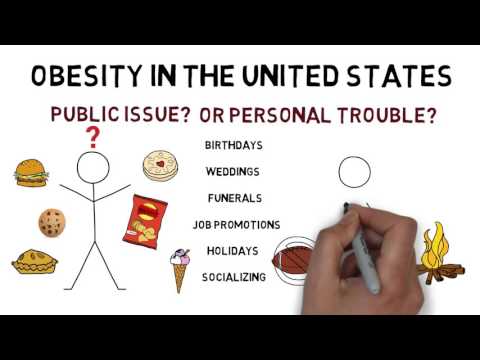
A YouTube element has been excluded from this version of the text. You can view it online here: http://pb.libretexts.org/insss/?p=50
[ “Sociological Imagination” by Sociology Live! is licensed under CC BY 4.0 ]
Self-Check: The Sociological Imagination
https://assessments.lumenlearning.com/assessments/990
- Self-Check: The Sociological Imagination. Authored by : Cathy Matresse and Lumen Learning. Provided by : Lumen Learning. License : CC BY: Attribution
- The Sociological Imagination. Provided by : College of the Canyons. Located at : https://www.canyons.edu/Offices/DistanceLearning/OER/Documents/Open%20Textbooks%20At%20COC/Sociology/SOCI%20101/The%20Sociological%20Imagination.pdf . Project : Sociology 101. License : CC BY: Attribution
- Sociological Imagination. Authored by : Cindy Hager. Provided by : Sociology Live!. Located at : https://www.youtube.com/watch?v=BINK6r1Wy78. . License : CC BY: Attribution
- Reading: Defining the Sociological Imagination. Provided by : Florida State College at Jacksonville. Located at : https://courses.lumenlearning.com/intro-to-sociology/chapter/the-sociological-imagination-add-image/ . License : CC BY: Attribution . License Terms : Modified Content
The Sociological Imagination C. Wright Mills
GradeSaver offers study guides, application and school paper editing services, literature essays, college application essays and writing help.
The Sociological Imagination Material
- Study Guide
Join Now to View Premium Content
GradeSaver provides access to 2360 study guide PDFs and quizzes, 11007 literature essays, 2767 sample college application essays, 926 lesson plans, and ad-free surfing in this premium content, “Members Only” section of the site! Membership includes a 10% discount on all editing orders.
The Sociological Imagination Essays
Sociological Imagination: Sociology Issues Essay
The COVID-19 pandemic has forced significant societal changes all over the world. The introduction of social distancing, face mask wearing, and economic downturn have led people to alter their lifestyles considerably. This paper aims to apply sociological imagination to COVID-19 to analyze how it has affected the lives of individuals and society as a whole. The paper will outline possible changes in social structures and social forces in the GCC region, which may happen as a result of the pandemic. I will also explain how these changes will affect my community and family.
The Definition of Sociological Imagination
Sociological imagination is a way to see the events of one’s own life in a broader context of social issues and trends. The term was coined by C. Wright Mills, who argued that “neither the life of an individual nor the history of a society can be understood without understanding both” (Smith-Hawkins, 2020, p. 8). Sociological imagination is defined as an awareness of the connection that exists between one’s behavior and experiences and the surrounding society that has shaped the individual’s choices and worldview (Griffiths et al., 2015). By applying sociological imagination to everyday life, people can see that their actions are largely influenced by the prevalent societal trends and practices.
Moreover, sociological imagination can show that the decisions people deem their own are actually made with the involvement of their families and communities. One may consider, for example, the decision to have children. In the past, having children was an indispensable part of people’s family lives. Nowadays, people have gained more freedom in deciding whether to have children. However, the eventual decision to reproduce is taken with regard to the culture in which the person lives. For example, in child-centric societies, people are less likely to remain childless because of the pressure they experience from their peers, parents, and the entire community. In Western countries, where the individualistic culture prevails, people do not experience such societal pressure in terms of having children, but they feel urged to boost their personal achievements. As a result, guided by these societal trends, they decide to postpone having children in order to build a career.
Although the term “sociological imagination” was invented by C. Wright Mills, the idea of integrating the lives of individuals and entire societies was used by earlier sociologists. For example, Karl Marx used sociological imagination to explain the process of social change (Griffiths et al., 2015). Marx argued that the social conflict between workers and capitalists would lead to tensions and revolts, which, subsequently, would end in a social change (Griffiths et al., 2015). Max Weber also applied his sociological imagination to understand society and argued that standard scientific methods were not applicable for predicting the behavior of human groups (Griffiths et al., 2015). Weber believed that sociology should take account of culture and get a deep understanding of different social groups rather than strive to obtain generalizable results (Griffiths et al., 2015). Thus, the concept of sociological imagination is essential in sociologists and has been used by scientists even before C. Wright Mills described and coined a term for it.
Possible Changes in Social Structures and Forces in a Post-COVID World
In a post-COVID world, many social structures are likely to change. According to Smith-Hawkins (2020), social structures are “any relatively stable pattern of social behavior found in social institutions” (p. 6). For example, one common social structure is status, which refers to the responsibilities and benefits that people exercise depending on their roles in society (Smith-Hawkins, 2020). In a post-COVID world, some people are likely to experience a change in their status. For example, the pandemic led many entrepreneurs to close their businesses because of the forced lockdown. As a result, these people are likely to lose their status as business owners and will have to find a new occupation. In addition, during the pandemic, the status of healthcare workers has significantly improved, which will probably influence the prestige and attractiveness of healthcare professions for individuals.
Another important social structure is formal organizations, such as banks, schools, hospitals, and others. Within these social structures, the changes include the emergence of new rules, such as face mask wearing, and the modification of the work format. During the pandemic, many organizations have transferred to remote work in response to the introduction of social distancing or were forced to lay off a large number of workers. As a result, individuals had to adapt to new circumstances. In the future, it is possible that the jobs that allow for the remote work format will become more valuable, along with various delivery services. In addition, these changes are likely to change people’s career choices in the future.
Social institutions are also part of social structures, and one important social institution that is likely to change in a post-COVID world is health and medicine. One possible change that healthcare in GCC will undergo is an increase in the use of telehealth. Social distancing, the contagiousness of the virus, and low access to care in rural areas are significant preconditions for the wide use of remote healthcare services.
Finally, in terms of social forces, it is likely that a social action directed toward improving economic policies will emerge. COVID-19 has sharpened social issues that have existed long ago in society, such as poverty and inequality. Many people have become unemployed or experienced a decrease in their incomes. These changes may lead to public discontent, forcing governments to revise their policies related to labor and the economy.
The Impact of Social Changes on the Community and Family
According to the concept of sociological imagination, individuals and society are closely interrelated, and individuals are highly influenced by changes occurring in society. Therefore, one can assume that the changes that will happen in a post-COVID world will influence communities and individuals with their families. Thinking of my community, I believe that healthcare workers will be respected even more than before for their contribution to the fight against the virus. I also think that many people in my community will experience a change in their status. Entrepreneurs who lost their businesses will have to change their social roles; many office workers will change their status to either unemployed or remote employees. As for the influence on my family, my relatives and I will have to adapt to the new economic environment and learn to function effectively under the circumstances of social distancing and remote work. Finally, if my assumptions about the social change in healthcare and policies related to labor and economy are right, both my community and family will benefit in terms of improved access to healthcare and labor conditions.
Griffiths, H., Keirns, N. J., Strayer, E., Cody-Rydzewski, S., Scaramuzzo, G., Sadler, T., Vyain, S., Bry, J., & Jones, F. (2015). Introduction to sociology (2 nd ed.). OpenStax College, Rice University. Web.
Smith-Hawkins, P. (Ed.). (2020). Introduction to Sociology (AUBH Bahraini ed.). Unpublished manuscript.
- Chicago (A-D)
- Chicago (N-B)
IvyPanda. (2022, October 27). Sociological Imagination: Sociology Issues. https://ivypanda.com/essays/sociological-imagination-sociology-issues/
"Sociological Imagination: Sociology Issues." IvyPanda , 27 Oct. 2022, ivypanda.com/essays/sociological-imagination-sociology-issues/.
IvyPanda . (2022) 'Sociological Imagination: Sociology Issues'. 27 October.
IvyPanda . 2022. "Sociological Imagination: Sociology Issues." October 27, 2022. https://ivypanda.com/essays/sociological-imagination-sociology-issues/.
1. IvyPanda . "Sociological Imagination: Sociology Issues." October 27, 2022. https://ivypanda.com/essays/sociological-imagination-sociology-issues/.
Bibliography
IvyPanda . "Sociological Imagination: Sociology Issues." October 27, 2022. https://ivypanda.com/essays/sociological-imagination-sociology-issues/.
- Post-COVID-19 Pandemic Policy Changes
- Reflection on the Post-COVID Education Articles
- The Impact of the COVID-19 Pandemic on the Future of Europe
- Restaurant Business During COVID-19 Pandemic
- Religious Persecution in Sociology
- Aspects of Straw Man Fallacy
- Noise Pollution: Effects, Causes, and Potential Solutions
- Obesity and Its Demographic Predictors

IMAGES
VIDEO
COMMENTS
2011. "Sociological Writing as Higher-level Thinking: Assignments that Cultivate the Sociological Imagination." Teaching Sociology 39(4): 371-381. Nell Trautner, Mary; Borland, Elizabeth. 2013. "Using the Sociological Imagination to Teach about Academic Integrity." Teaching Sociology 41(4): 377-388. Noy, Shiri. 2014. "Secrets and the ...
A sociological imagination "is the ability to see the relationship between individual experiences and the larger society.". Sociological imagination helps us think how we experience as our personal problems. Some of these personal problems include homelessness, domestic violence, addiction, unemployment, obesity, etc.
The sociological imagination is a method of thinking about the world. As you may have guessed, it's part of the field of sociology, which studies human society. When you put "sociological"—studying society—and "imagination"—the concept of forming new ideas, often creatively—together, you get a pretty good definition of the ...
Applying the Sociological Imagination Essay. Emma Fisher Galen College of Nursing Sociology 1305 Professor Lee. Applying the Sociological Imagination Essay Introduction C. Wright Mills, the pioneering sociologist, defined sociological imagination as an awareness of a relationship between a person's behavior and experience that influences the person's choices and perceptions (OpenStax, 2016).
The real power of the sociological imagination is found in how we learn to distinguish between the personal and social levels in our own lives. This includes economic challenges. For example, many students do not purchase required textbooks for college classes at both 2-year colleges and 4-year colleges and universities.
Summary. The term sociological imagination describes the type of insight offered by sociology; connecting the problems of individuals to that of broader society. C. Wright Mills, the originator of the term, contended that both sociologists and non-academics can develop a deep understanding of how the events of their own lives (their biography ...
The late, great sociologist C. Wright Mills wrote eloquently of what he called "the sociological imagination," which involved the ability to connect our own biographies to the wider currents of history, to understand the various social and cultural components of who we become. That was a major corrective to the highly individualistic ...
As a college student, understanding the concept of sociological imagination is crucial for analyzing the complexities of the social world. The ability to see beyond individual experiences and recognize the broader social forces at play is essential for developing a holistic understanding of society. This essay aims to explore the definition of sociological imagination, its importance in ...
Words: 627 Pages: 2 8696. Sociological Imagination is a concept in sociology that helps interlink personal experiences to the wider social forces. It is the capacity to think systematically about social issues that people in a society all have in common. Hunger, poverty, and obesity are all examples of common social issues that exist within a ...
THROUGH WRITING SOCIOLOGICAL AUTOBIOGRAPHY*. Sociological imagination is a quality of mind that cannot be adopted by simply. teaching students its discursive assumptions. Rather, it is a disposition, in. competition with other forms of sensibility', which can be acquired only when. it is practiced. Adhering to this important pedagogical ...
Example of Sociological Imagination. Sociological imagination is a concept put forward by the sociologist C. Wright Mills in 1959. It refers to the ability to see the intersection between personal troubles and public issues, and to understand how these two are connected. At its core, sociological imagination allows individuals to critically ...
Sociological Imagination as a Tool for Engaged Citizenship. The goal of this essay is to place engaged citizenship in the context of Mills's sociological imagination that involves being able to link one's personal experiences to processes taking place in wider society. Sociological Imagination of Homosexuality.
Introduction. Sociology is an interdisciplinary field that has much to offer. The sociological imagination as Mills (Citation 1970 / Citation 2000) proposed it comprises 'vivid awareness of the relationship between personal experience and the wider society' (p. 5).While much debate surrounds the idea of the sociological imagination, it is often understood as an outlook, one that steers us ...
The sociological imagination, a concept established by C. Wright Mills (1916-1962) provides a framework for understanding our social world that far surpasses any common sense notion we might derive from our limited social experiences. Mills was a contemporary sociologist who brought tremendous insight into the daily lives of society's members.
The sociological imagination by Mills provides a framework for understanding our social world that far surpasses any common sense notion we might derive from our limited social experiences. C. Wright Mills (1916-1962) was a contemporary sociologist who brought tremendous insight into the daily lives of society's members.
Developing Sociological Imagination at National University . National University is a regionally accredited institution that offers a Bachelor of Arts in Sociology as well as several programs in criminal justice that enable students to develop and use concepts like sociological imagination for application in the real world. Students learn to apply their ability to enhance human interactions in ...
The Sociological Imagination C. Wright Mills. GradeSaver offers study guides, application and school paper editing services, literature essays, college application essays and writing help. The Sociological Imagination Material. Study Guide; Q & A; Join Now to View Premium Content
The sociological imagination is a concept developed by sociologist C. Wright Mills in 1959. It refers to the ability to see the relationship between individual experiences and larger social forces. This essay will explore the concept of sociological imagination, its significance in understanding society, and its applications in various fields.
To understand sociological imagination, you don't often have to look any further than your everyday behavior. Learn more about what it means with our examples. ... You might think this is a solitary path: you have to pass the tests, you have to nail the college entrance essays. But, is it such a solitary path? Never mind the obvious point that ...
Although the term "sociological imagination" was invented by C. Wright Mills, the idea of integrating the lives of individuals and entire societies was used by earlier sociologists. For example, Karl Marx used sociological imagination to explain the process of social change (Griffiths et al., 2015). Marx argued that the social conflict ...
Sociological Imagination. Galen College SOC 1305 9/10/ 2 Sociological imagination was introduced in 1959 by C. Wright Mills (OpenStax, 2015). It is the awareness of the relationship between the self and the wider society. How I sum it up and understand is how something you do fits into society.
Conclusion. In conclusion, sociological imagination is a powerful tool for understanding and analyzing social phenomena. By enabling individuals to see the connections between personal experiences and larger social and historical forces, sociological imagination encourages critical thinking and a deeper understanding of social issues. Moreover, it has implications for individual and collective ...
Sociological Imagination Essay Galen College of Nursing SOC 1305: Sociology Professor Donald Anderson March 17, 2024. Sociological Imagination Essay Introduction C. Wright Mills was a pioneer sociologist who described sociological imagination as an understanding of how a person's behavior and experiences are influenced by the culture they grew up in (Conerly et al., 2021).